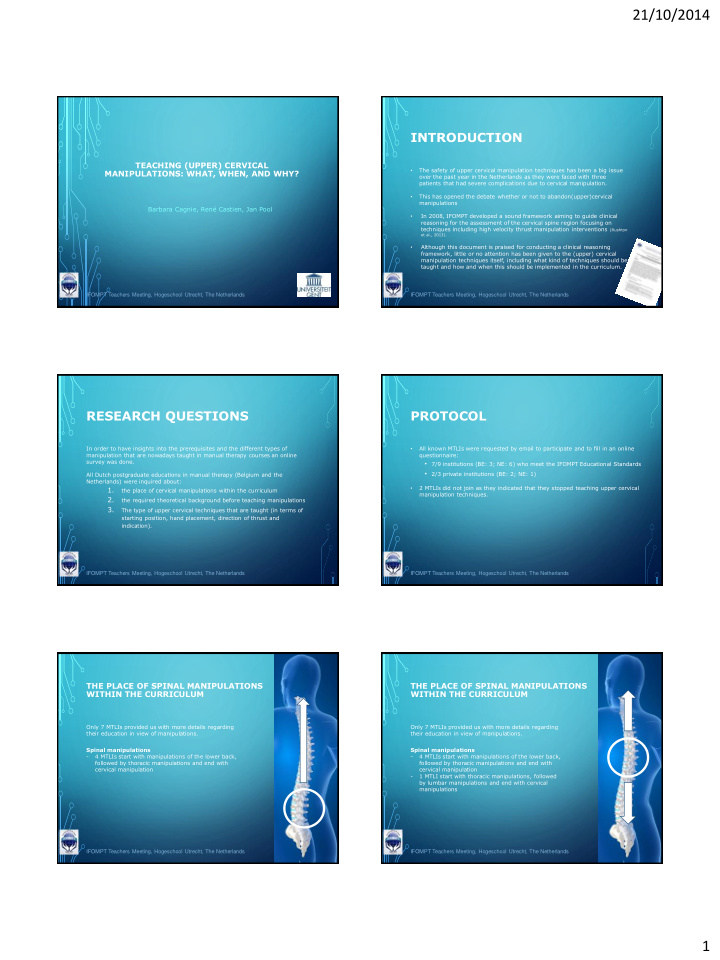



21/10/2014 INTRODUCTION TEACHING (UPPER) CERVICAL The safety of upper cervical manipulation techniques has been a big issue • MANIPULATIONS: WHAT, WHEN, AND WHY? over the past year in the Netherlands as they were faced with three patients that had severe complications due to cervical manipulation. This has opened the debate whether or not to abandon(upper)cervical • manipulations Barbara Cagnie, René Castien, Jan Pool • In 2008, IFOMPT developed a sound framework aiming to guide clinical reasoning for the assessment of the cervical spine region focusing on techniques including high velocity thrust manipulation interventions (Rushton et al., 2013). Although this document is praised for conducting a clinical reasoning • framework, little or no attention has been given to the (upper) cervical manipulation techniques itself, including what kind of techniques should be taught and how and when this should be implemented in the curriculum. IFOMPT Teachers Meeting, Hogeschool Utrecht, The Netherlands IFOMPT Teachers Meeting, Hogeschool Utrecht, The Netherlands RESEARCH QUESTIONS PROTOCOL In order to have insights into the prerequisites and the different types of All known MTLIs were requested by email to participate and to fill in an online • manipulation that are nowadays taught in manual therapy courses an online questionnaire: survey was done. • 7/9 institutions (BE: 3; NE: 6) who meet the IFOMPT Educational Standards • 2/3 private institutions (BE: 2; NE: 1) All Dutch postgraduate educations in manual therapy (Belgium and the Netherlands) were inquired about: • 2 MTLIs did not join as they indicated that they stopped teaching upper cervical 1. the place of cervical manipulations within the curriculum manipulation techniques. 2. the required theoretical background before teaching manipulations 3. The type of upper cervical techniques that are taught (in terms of starting position, hand placement, direction of thrust and indication). IFOMPT Teachers Meeting, Hogeschool Utrecht, The Netherlands IFOMPT Teachers Meeting, Hogeschool Utrecht, The Netherlands THE PLACE OF SPINAL MANIPULATIONS THE PLACE OF SPINAL MANIPULATIONS WITHIN THE CURRICULUM WITHIN THE CURRICULUM Only 7 MTLIs provided us with more details regarding Only 7 MTLIs provided us with more details regarding their education in view of manipulations. their education in view of manipulations. Spinal manipulations Spinal manipulations - 4 MTLIs start with manipulations of the lower back, - 4 MTLIs start with manipulations of the lower back, followed by thoracic manipulations and end with followed by thoracic manipulations and end with cervical manipulation cervical manipulation - 1 MTLI start with thoracic manipulations, followed by lumbar manipulations and end with cervical manipulations IFOMPT Teachers Meeting, Hogeschool Utrecht, The Netherlands IFOMPT Teachers Meeting, Hogeschool Utrecht, The Netherlands 1
21/10/2014 THE PLACE OF SPINAL MANIPULATIONS THE PLACE OF CERVICAL MANIPULATIONS WITHIN THE CURRICULUM WITHIN THE CURRICULUM Only 7 MTLIs provided us with more details regarding Cervical manipulations : their education in view of manipulations. - 5 MTLIs start with low-cervical manipulations, followed by mid- cervical spine manipulations - 2 MTLIs start off with mid-cervical manipulations followed by low- Spinal manipulations cervical manipulations. - 4 MTLIs start with manipulations of the lower back, - All MTLIs save upper cervical manipulations till the end. followed by thoracic manipulations and end with cervical manipulation - 1 MTLI start with thoracic manipulations, followed by lumbar manipulations and end with cervical manipulations - 2 MTLIs start with cervical manipulation, followed by thoracic manipulations and end with lumbar manipulations IFOMPT Teachers Meeting, Hogeschool Utrecht, The Netherlands IFOMPT Teachers Meeting, Hogeschool Utrecht, The Netherlands REQUIRED THEORETICAL THE NUMBER OF CONTACT HOURS FOR SPINAL BACKGROUND BEFORE STARTING MANIPULATION TO TEACH MANIPULATIONS Spinal manipulations : - 53.3 ± 28.8 hours (range 30 – 96 hours) The following items were indicated as a prerequisite to start teaching (cervical) manipulations: Knowledge of the anatomy of the (upper) cervical spine • Biomechanics, with specific focus on coupled motions • Cervical manipulations : Underlying mechanisms and principles of spinal manipulation, including • - Mid/low cervical manipulations: positioning, locking, … 16.7 ± 8.2 (range: 8-32) • Pathophysiology in relation to indications and contra-indications of (upper) cervical manipulations - Upper cervical manipulations: • Precautions and risk factors of (upper)cervical manipulations 8.7 ± 5.2 (range: 3-18) Advanced clinical reasoning • Premanipulative screening including upper cervical instability tests, VBI- • tests, neurological tests, … IFOMPT Teachers Meeting, Hogeschool Utrecht, The Netherlands IFOMPT Teachers Meeting, Hogeschool Utrecht, The Netherlands (dis)traction Translation (rotation) Gapping OVERVIEW OF THE DIFFERENT manipulation manipulation (sidebending) manipulation TECHNIQUES ACQUIRED AT C0-C1 Supine Number of MTLIs N = 9 N = 1 N=5 Terminology traction (n=9) Translation contra-technique Sidebending (n=5) THE DIFFERENT MTLIS Sitting Number of MTLIs N = 4 N = 5 Terminology Traction (n=4) Sidebending (n=5) • Different terminologies to classify the different techniques are used by the C1-C2 Supine Number of MTLIs N = 3 N = 6 * N = 2 Terminology Traction (n=4) PA-thrust (n=1) Gapping (n=1) different MTLIs. rotation (n=3) Side bending (n=1) translation (n=1) • In an attempt to list all upper cervical manipulation techniques of the rotation contra-technique (n=1) rotation mitnehmer (n=1) different MTLIs, manipulation techniques are classified Sitting Number of MTLIs N = 2 N = 3 • per segment (C0-C1, C1-C2 and C2-C3), Terminology Traction (n=2) Rotation (n=1) Translation (n= 1) • per direction of thrust ((dis)traction, translation/rotation or Rotation mitnehmer (n=1) gapping/sidebending) C2-C3 Supine Number of MTLIs N = 5 N = 6 * N = 4 Terminology Traction (n=5) Flexion gliding (upslope) (n=4) Gapping (n=2) • per starting position (sitting/loaded or supine/unloaded). extension gliding (downslope) Side bending (n=1) (n=3) Transverse thrust (n=1) Rotation mitnehmer (n=2) • For each technique, the number of MTLIs where the technique is acquired Flexion flick (up- + downslope) (n=1) and the used terminology is mentioned. Sitting Number of MTLIs N = 2 N = 4 * Terminology Traction (n=2) Rotation mitnehmer (n=4) Rotation Contratechniek (n=1) Rotation gegenhalt (n= 1) Translation (n=1) IFOMPT Teachers Meeting, Hogeschool Utrecht, The Netherlands IFOMPT Teachers Meeting, Hogeschool Utrecht, The Netherlands 2
Recommend
More recommend